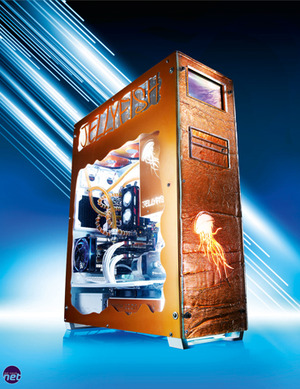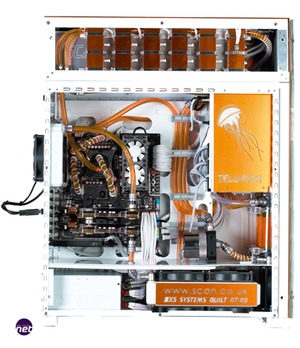
The Scan Jellyfish unveiled
Every year we challenge the world's leading professional PC builders to craft the most technologically advanced, innovative, eye-catching PCs they can. We call this competition Dream PCs, and here is the fith and final entry - the TEC water-cooled Scan Jellyfish.In Scan's own words 'Vision, Concept, Process, Structure – these are the ingredients without which it would be impossible to build a Dream PC.'
'After winning two years on the run, you can’t help but feel you have to better yourself. If anyone had asked us last year if we could do better than Great White, we would have been hard pushed to say yes. We put ourselves through hell each year, with all the emotions needed to build a work of art.'
'Our vision was to build a PC that people will remember in the years to come.'
'Our concept was a rig built to resemble an exotic creature (following our Dream PCs theme). The Jellyfish was formed, a translucent orange and dangerously fast PC with copious attention to detail.'
Scan continues 'The process involved spending hundreds of man
 hours to find the best hardware, which we could use to make our vision a reality. Working closely with our loyal suppliers, we evaluated and tested many combinations of hardware to finally settle on a mix worthy enough to use.'
hours to find the best hardware, which we could use to make our vision a reality. Working closely with our loyal suppliers, we evaluated and tested many combinations of hardware to finally settle on a mix worthy enough to use.''For our structure, we decided to use the brand new Corsair Obsidian 800D chassis. This allowed us to break from the past mould of the SilverStone TJ07,giving us more room to play with. Four new aluminium panels were designed and laser cut for the front, sides and top of the chassis. Jellyfish logos were cut both into one of the side panels and the front panel. A new glass front panel was manufactured, which gave the front of the system a water-like/ice effect. This panel had the Jellyfish logo etched into it along with adequate spacing for the Blu-ray drive and 7in LCD screen.'
'We first tested and used Thermo Electric Coolers (TECs) back in Dream PC 2005, and applied what we learnt from this into creating a new triple-loop cooling system incorporating six banks of CoolIT TECS working alongside an array of single, dual and triple radiators.
The TEC system we implemented allowed us to push the Intel Core i7-975 Extreme Edition from its stock 3.33GHz to 4.4GHz. During our research we trialled and tested many different CPUs including an Intel Core i7-950, Intel Xeon W3580 and found that the i7-975 gave us the best performance gains.'
'A new partition was constructed that would house both the triple fan TFC Monsta radiator, the collection of TECs/waterblocks and a 7in LCD panel. This was mounted on top of the Corsair case and allowed the inside of the case to have a much cleaner look without all the cooling components being packed into the original skeleton.'
'A sheet of white Perspex was cut to size and placed into the base of the middle section of the chassis to give a minimalistic clean look.
 The 1.2kW Enermax PSU was disassembled and the exterior of it painted white to fit in with the rest of the chassis colour scheme. All of the modular cables and ATX cables that extruded from the PSU were re-sleeved with white braiding. Beautiful.'
The 1.2kW Enermax PSU was disassembled and the exterior of it painted white to fit in with the rest of the chassis colour scheme. All of the modular cables and ATX cables that extruded from the PSU were re-sleeved with white braiding. Beautiful.''On the rear side of the motherboard ,directly behind the CPU socket, we noticed that after the system had been stress testing for a significant amount of time, this area of the case was becoming very hot indeed, so to help cool things down we mounted a 120mm Enermax Cluster case fan to the back of the motherboard to allow airflow to bring this temperature down. This turned out to be very efficient and gave us the potential to possibly clock the CPU further.'
'All the fans (bar the intake fans, which are BIOS controlled) within the Jellyfish system are temperature controlled through the Aquaero unit housed below the 7in LCD panel. This allows the system to run at optimal noise levels. The harder you push the processor and graphics card, the faster the fans will spin to compensate for the heat produced and vice versa. When the new front for the case was designed we realised it would be necessary to relocate the front panel, which gave access to power and reset switches, as well as USB and audio sockets. This was relocated into the top section, enabling us to enhance the cable and tubing management. The end result is a work of art. It’s our best yet, win or lose.'
The full review of the Scan Jellyfish, along with this year's four other Dream PCs, will be published in bit-tech's sister magazine, Custom PC, on-sale 22 October. In the meantime, let us know your thoughts in the forums.

MSI MPG Velox 100R Chassis Review
October 14 2021 | 15:04








Want to comment? Please log in.